From Mary Quant to Moschino's newly-appointed Davide Renne, Vogue honours the impactful figures lost to the fashion world in 2023
The end of the year is a time for celebration, but also reflection and commemoration. Here, we look back at some of the fashion figures we lost in 2023. They include Davide Renne, 46, who had just been appointed creative director of Moschino, as well as nonagenarians Marc Bohan, who spent three decades at Christian Dior; Mica Ertegun, tastemaker/interior designer/philanthropist; Queens-born model Barbara Mullen; Seventh Avenue success story Leo Narducci, and Youthquake designer, Mary Quant. The industry, and by extension the world, has been impacted by all whose names appear below. They will be dearly missed.
Mica Ertegun, Tastemaker, Interior Designer, Philanthropist, 97
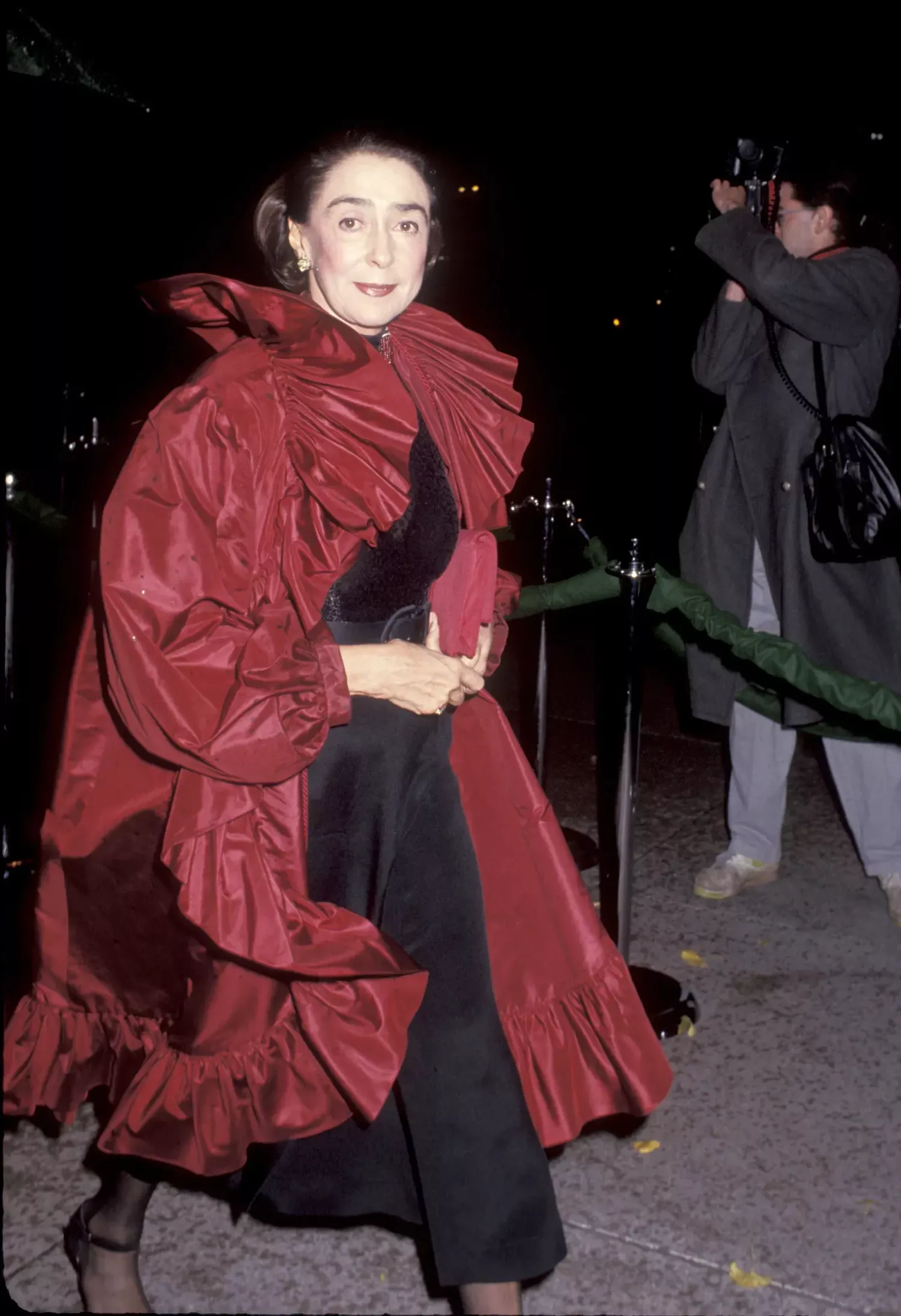
Mica Ertegun in 1992. . Photo: Ron Galella / Getty Images
“I don’t like paillette dresses; I prefer simplicity,” said Mica Ertegun in a 2001 profile. Hamish Bowles described her approach to style as having “rigorous discipline combined with a theatrical sensibility,” and the same might be said of the interiors she designed.
Ertegun’s life story, related by Bowles, reads like a novel. Born in Romania, “she escaped the Soviet oppressors together with her countrywoman Queen Elizabeth of Greece, and on the royal train, no less.” Her journey included stops in Switzerland and Paris, where she modeled for Bruyere, and then on to Canada, to manage a chicken farm with her first husband, Stefan Grecianu. In a coup de foudre, Ertegun met and married Ahmet Ertegun, founder of Atlantic Records, in 1961. Having studied interior design, in 1967 she created MAC II, a decorating business, with Chessy Rayner.
The inseparable friends were known for shopping together and for their mutual passion for Madame Grès’s draped jersey dresses, some of which were exhibited in the designer’s monographic exhibition at the Costume Institute. Ertegun entered the International Best-Dressed List Hall of Fame in 1971. Mica, Oscar de la Renta told Vogue, “has always been herself; she takes from fashion what she thinks is right for her, and what is not right—well, she won’t put it on!” Specific about her own tastes, Ertegun was a generous philanthropist and hostess. As Vogue wrote in 1977, Mica had a “genius for making other people happy.”
Leo Narducci, Fashion Designer, 91
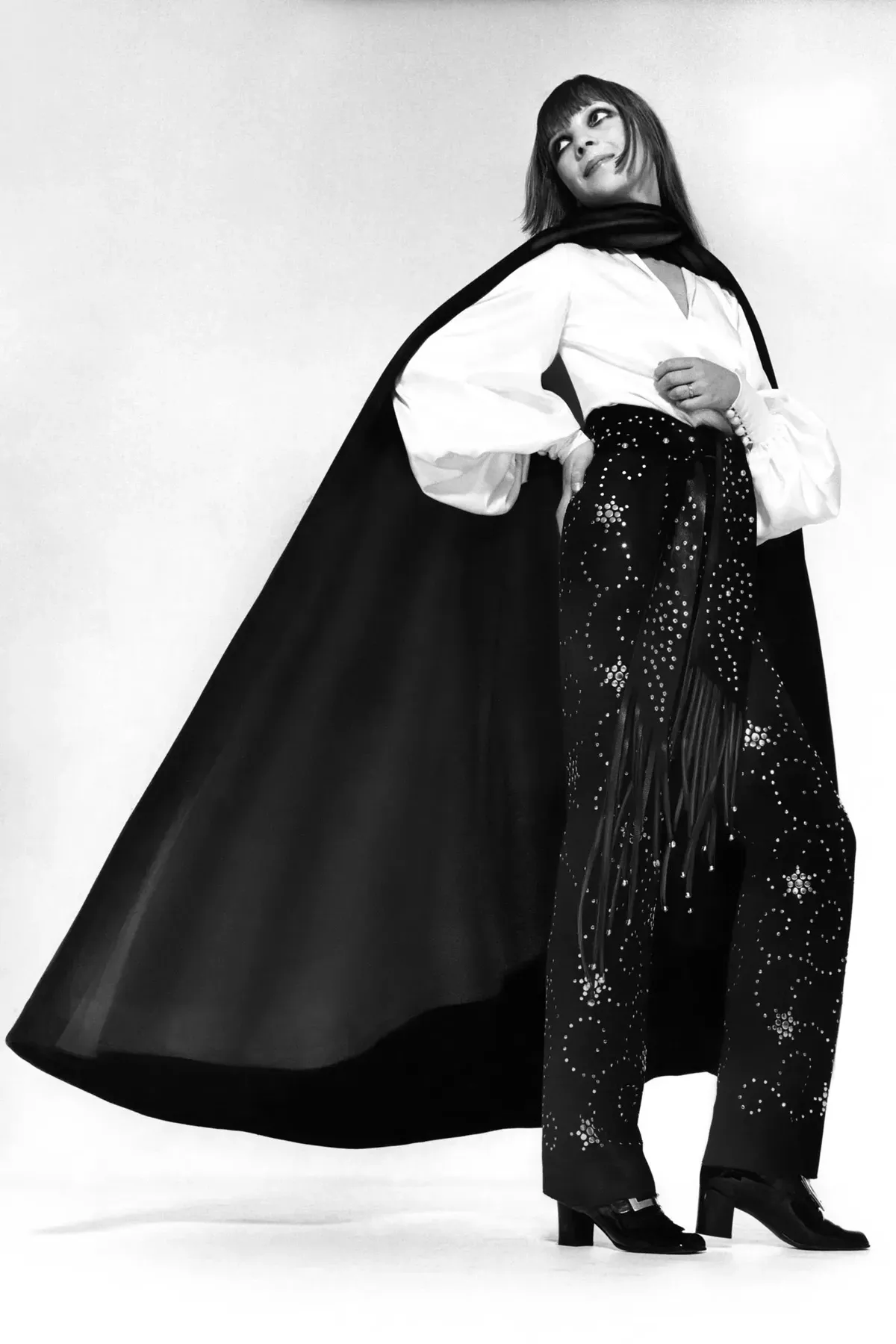
Penelope Tree in a cape, blouse, and fringed and studded pants by Leo Narducci. . Photo: David Bailey
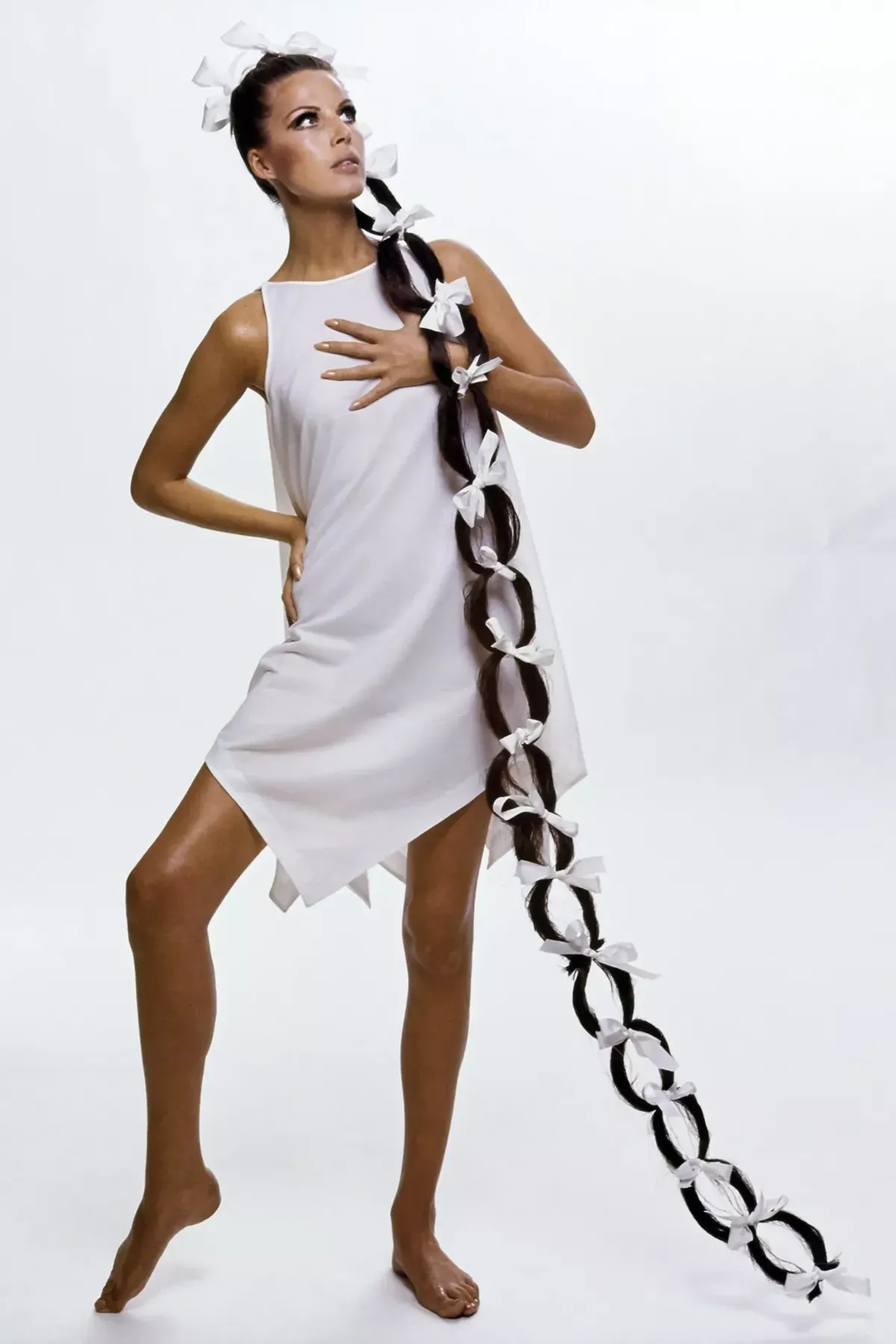
Birgitta AF Klerckerin a dress from Guy D by Leo Narducci. Photo: Bern Stern
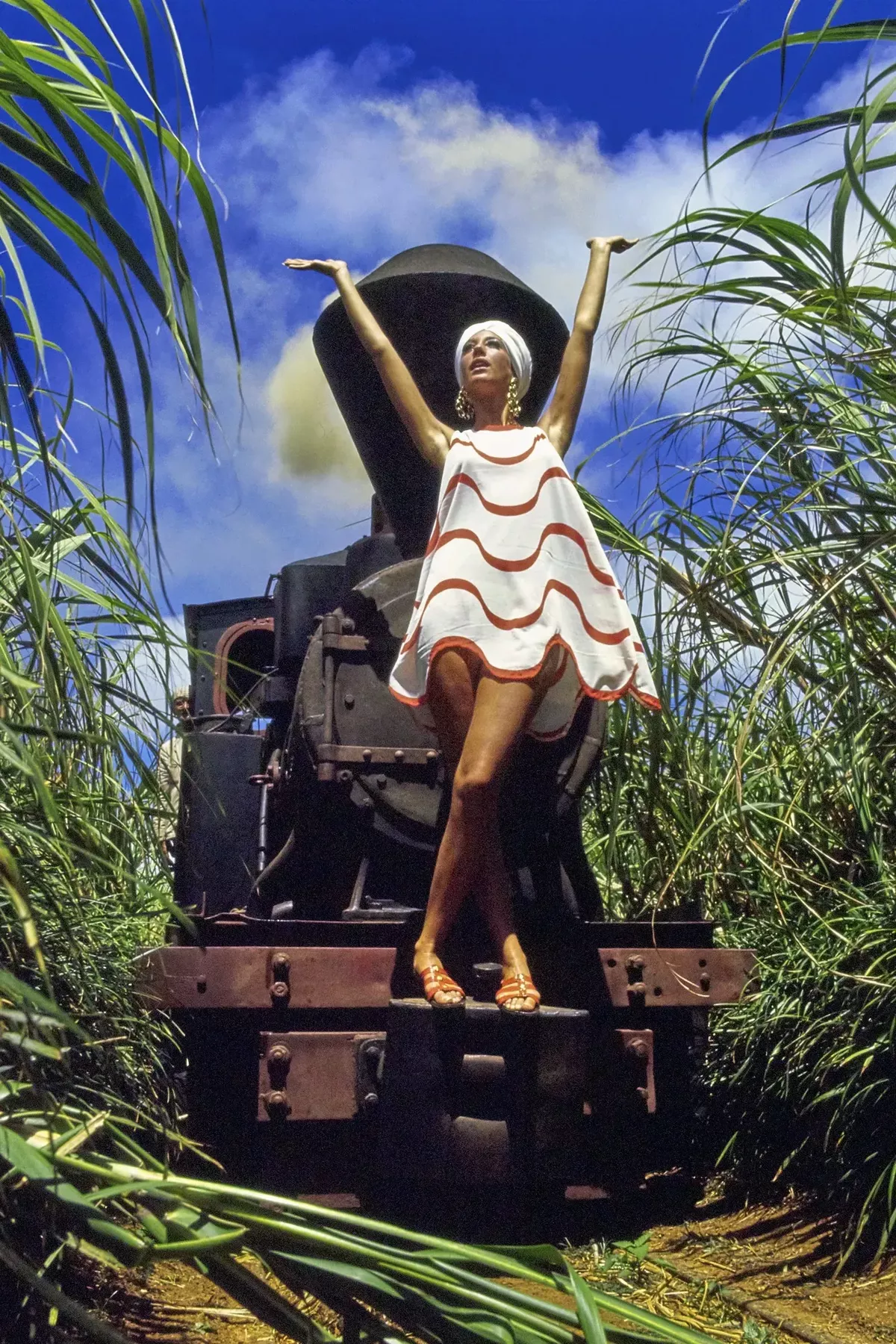
Marisa Berenson in a Guy D by Leo Narducci minidress. Photo: Arnaud De Rosnay
“I like soft clothes,” said the dashing Leo Narducci in a 1984, further burnishing his reputation, per WWD, as a “nice-’n-easy designer with a penetrating astute business sense.” Born in Brockton, Massachusetts, his parents were fashion contractors. “I ended up in business school at Boston University because my father was determined that I stay out of the rag trade. I flunked out,” he said in an interview. He spent four years in the Air Force, and enrolled at RISD upon his return.
Narducci started his career in 1960 on Seventh Avenue, and soon was credited on Guy D.’s label. He won a Coty Award in 1965 and launched his own line in 1967, backed by Ben Shaw, the businessman behind Geoffrey Beene and Oscar de la Renta. Narducci’s approach was more democratic than that of those designers, and perhaps a bit younger too. He said he liked to observe what the kids were wearing in Tompkins Square Park, and he was attuned to what middle class women of various shapes and sizes needed to get on with their lives. “The idea,” he once said, “is clothes for everyone–good design.” Narducci was enthusiastic about wash and wear materials and let fabric guide his designs. His motto: “Happiness is when people feel a close relationship to your clothes.”
Mark Eisen, Fashion Designer and Sculptor, 65

Claudia Schiffer wears a Mark Eisen jacket and pants. Photo: Arthur Elgort,
“The last thing I want to be is a designer who sits shuttered in his office, smoking cigarettes and sketching unwearable things,” Mark Eisen told Vogue in 1994, four years after making his debut in the magazine. Born in South Africa, he moved to Los Angeles at 19 to attend USC. There was a sunniness to Eisen’s minimal designs, which he married to a “Take Ivy” vibe that originated in his own experience of wearing a school uniform. But Eisen was no prep: “Basically, I’m a rock-’n’-roll kind of guy,” he told Vogue.
The magazine reported that he was “a serious, albeit self-taught, tailor who made a serious splash in the late '80s with neat little denim suits that he sketched at his kitchen table.” From that table grew an empire. Eisen’s focus shifted over time; in 2007 he moved back to South Africa where he restored a historic wine farm and started to explore industrial design. This evolved into a late career as a sculptor.
Davide Renne, Fashion Designer, 46
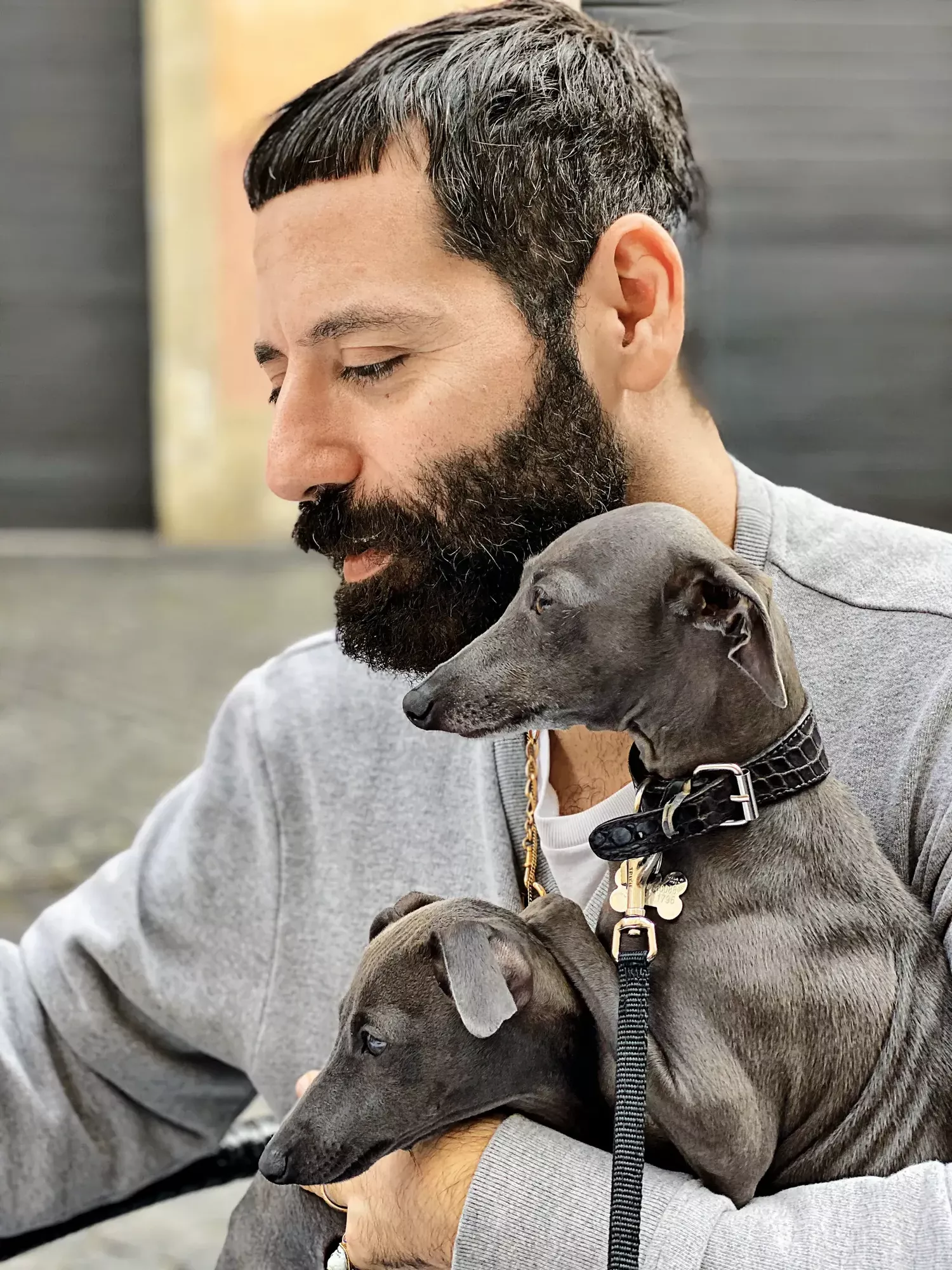
Davide Renne. Photo: Courtesy of the friends and family of Davide Renne
The Italian designer Davide Renne had the unique ability to both stand out, as when he wore avant-garde designers in his small hometown of Follonica, and to fit in, as he did at Gucci, which was his work home for two decades.
An avid sketcher who once dreamed of pursuing architecture, Renne studied at Polimoda at the University of Florence. Upon graduating in 2000, he moved to Milan and worked for Alessandro Dell’Acqua. He started at Gucci four years later, and came up in the company alongside his great friend, Alessandro Michele. He was appointed creative director of Moschino earlier this year. Tragically he died ten days into his tenure.
Countess Marina Cicogna, Film Producer and Photographer, 89

Photo: Cecil Beaton
The glamorous Countess Marina Cicogna was a woman of status, independence, and elegance long before she was cast by Alessandro Michele when he was at Gucci. Not only was she snapped for Vogue, she also contributed photographs to the magazine – including portraits of Jeanne Moreau and Brigitte Bardot. Cicogna’s first appearances in its pages, as a subject, were in April 1965; she was photographed at home at Villa Volpe by Cecil Beaton and by Slim Aarons for a feature story titled “The Beautiful People in Mexico.”
A member of the 1960s jet-set, she defied expectations to become, according to the New York Times, “one of the most powerful women in European cinema, as both a producer and a distributor.” Cicogna, wrote Diane Von Furstenberg, was an “unconventional and beautiful countess who broke the rules of aristocracy by going into the movie business.” In fact, the entire family was involved one way or another with cinema. Her father helped fund Bicycle Thieves, and her mother owned Euro International Films, which she transferred to her daughter and son. In 1967, Cicogna had three films playing at the Venice Film Festival, which was founded by her grandfather. The siblings threw a legendary party in the floating city. It would turn out that there was much to celebrate: The Cigona-produced Belle de Jour won the top prize, the Golden Lion. Cicogna would work with Pierpaolo Pasolini (on Medea and Teorema), Franco Zeffirelli (on Brother Sun Sister Moon), and many other projects, including Investigation of a Citizen Above Suspicion, which took home the best foreign-language film Oscar in 1971. In addition to exhibiting and publishing her photographs, Cicogna was the subject of a 2021 documentary; her autobiography was released this year.
Gail O’Neill, Model and Journalist, 60

Gail O’Neill for Perry Ellis, spring 1987. Photo: Fairchild Archive/Getty Images
Gail O’Neill was a Wesleyan graduate with a job at Xerox when she was discovered at JFK on her way back from vacation in 1985. Within a year this Westchester, New York native was on the cover of British Vogue and part of what was being described at the time as a renaissance of Black models. She was a member of the Bethann Hardison and Iman’s Black Girls Coalition and appeared in Vogue Italia’s Black Issue in 2008, but by then she was enjoying a second fame as a journalist. She acted as a correspondent for The Early Show on NBC and subsequently worked with CNN and HGTV. O’Neill moved to Atlanta in 2000 where she wrote about art and was heard on NPR via WBAE.
Michael Leva, Designer and Consultant, 62
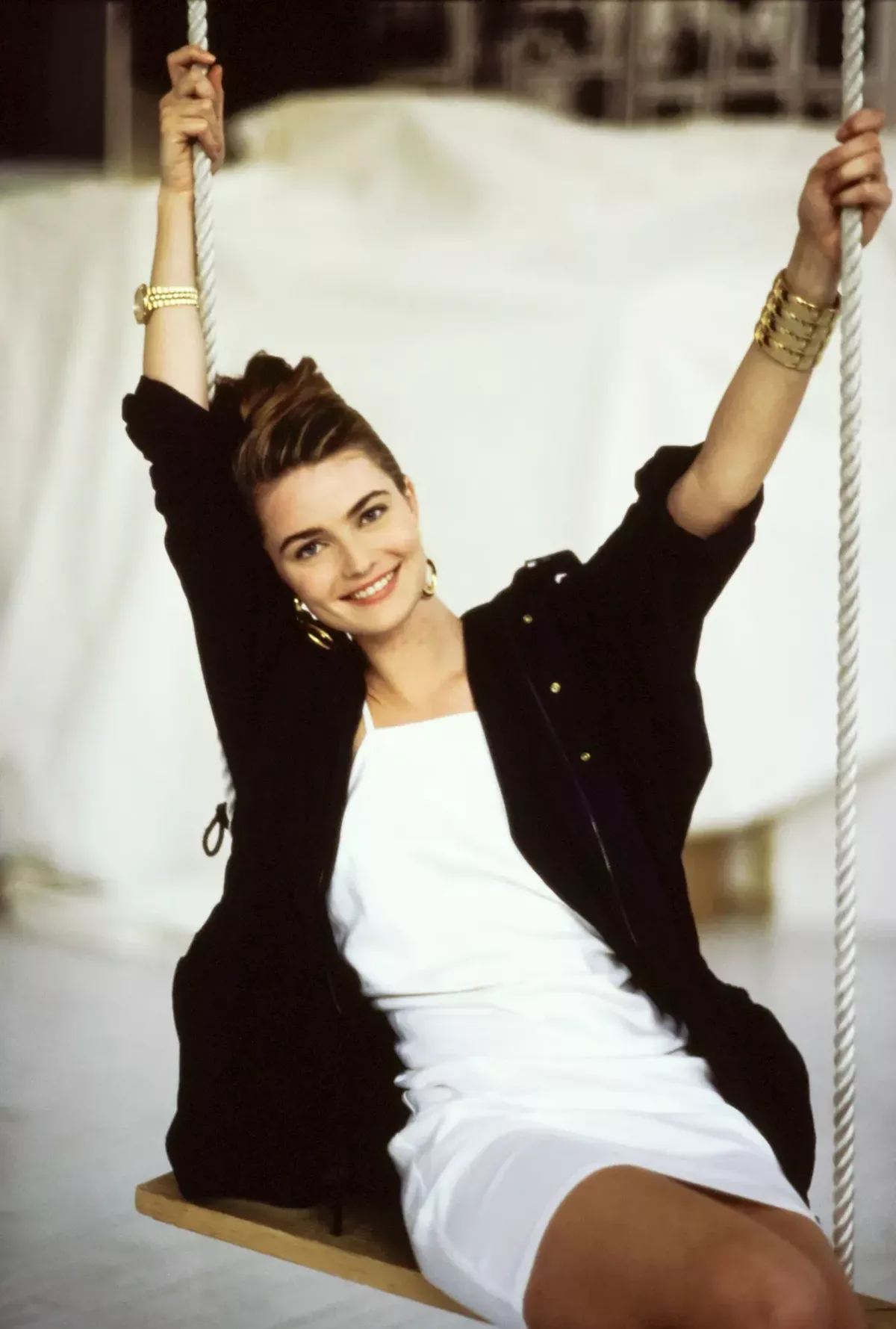
Paulina Porizkova in a white cotton dress by Michael Leva. Photo: Arthur Elgort
Michael Leva’s 1986 debut collection, presented, wrote the New York Times, at “the Soho boutique of the nightlife impresario Susanne Bartsch” and featuring “tie-dyed taffeta evening dresses on models who strode out to music by Nico and the Velvet Underground” sounds pretty splashy, but 1989 was actually his breakthrough year. It’s then that Vogue profiled the young New Jersey-ite, who enrolled at RISD to study landscape architecture and switched to fashion because he “liked the immediacy of grabbing the fabric, throwing it on the form, pinning it. It’s similar to what I love about gardening: the hands-on experience.”
Vogue reported that the designer’s studio was “terrifyingly spare. What is on the walls is a carefully orchestrated grouping of tearsheets and memorabilia; wreaths of dried flowers in muted pastels, an HG tearsheet of “mad gardener” C. Z. Guest wearing a Mainbocher coat, pages from Diana Vreeland’s Man and the Horse. One of Leva’s own Hermès riding boots is tossed behind the desk.” The magazine summed him up as “a new-wave monk more than a fashion designer.” Yet in his hands jersey and other materials followed the curves of the body seductively, but subtly. Though off to a strong start, Leva couldn’t make ends meet and closed his business in 1991, but continued to work as a consultant in the industry and as a lecturer at his alma mater. A tastemaker, Leva co-authored the book Recipes for Parties in 2014.
Barbara Mullen, Model, 96
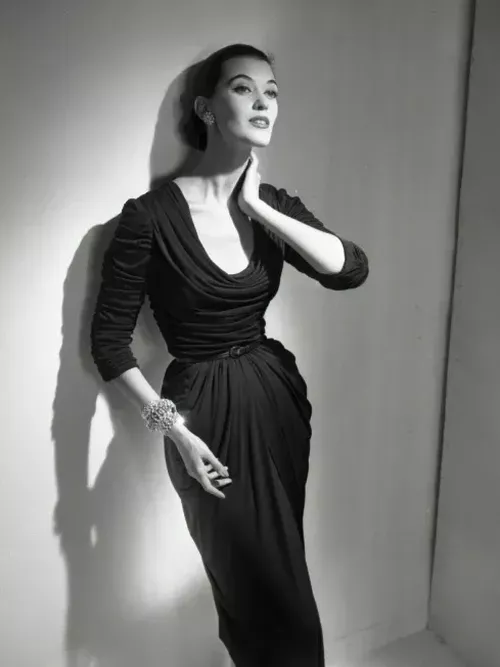
Barbra Mullen in a Talmack dress. Photo: Horst P. Horst
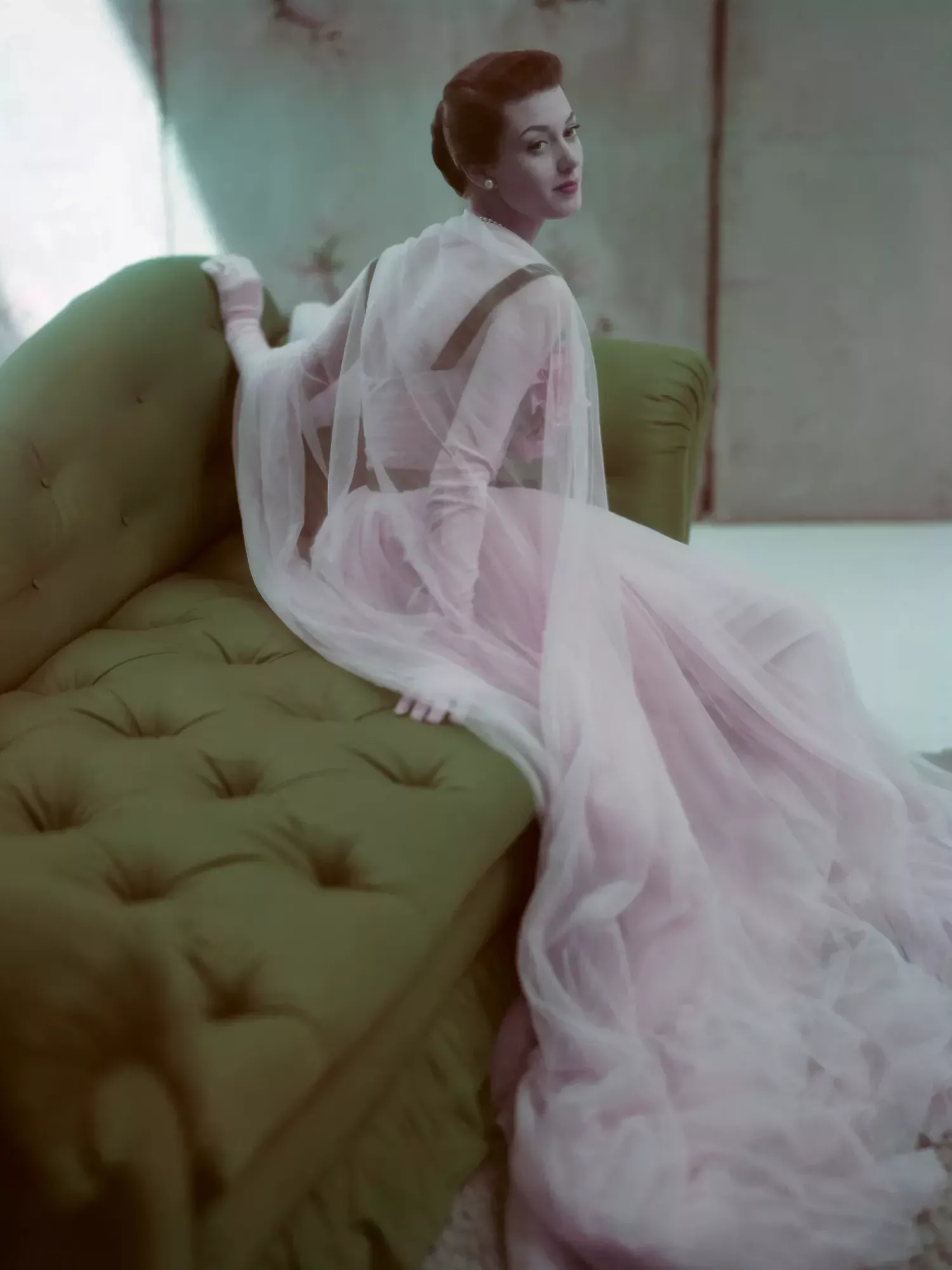
Barbra Mullen in a made-to-order dress from Bergdorf Goodman. Photo: John Rawlings
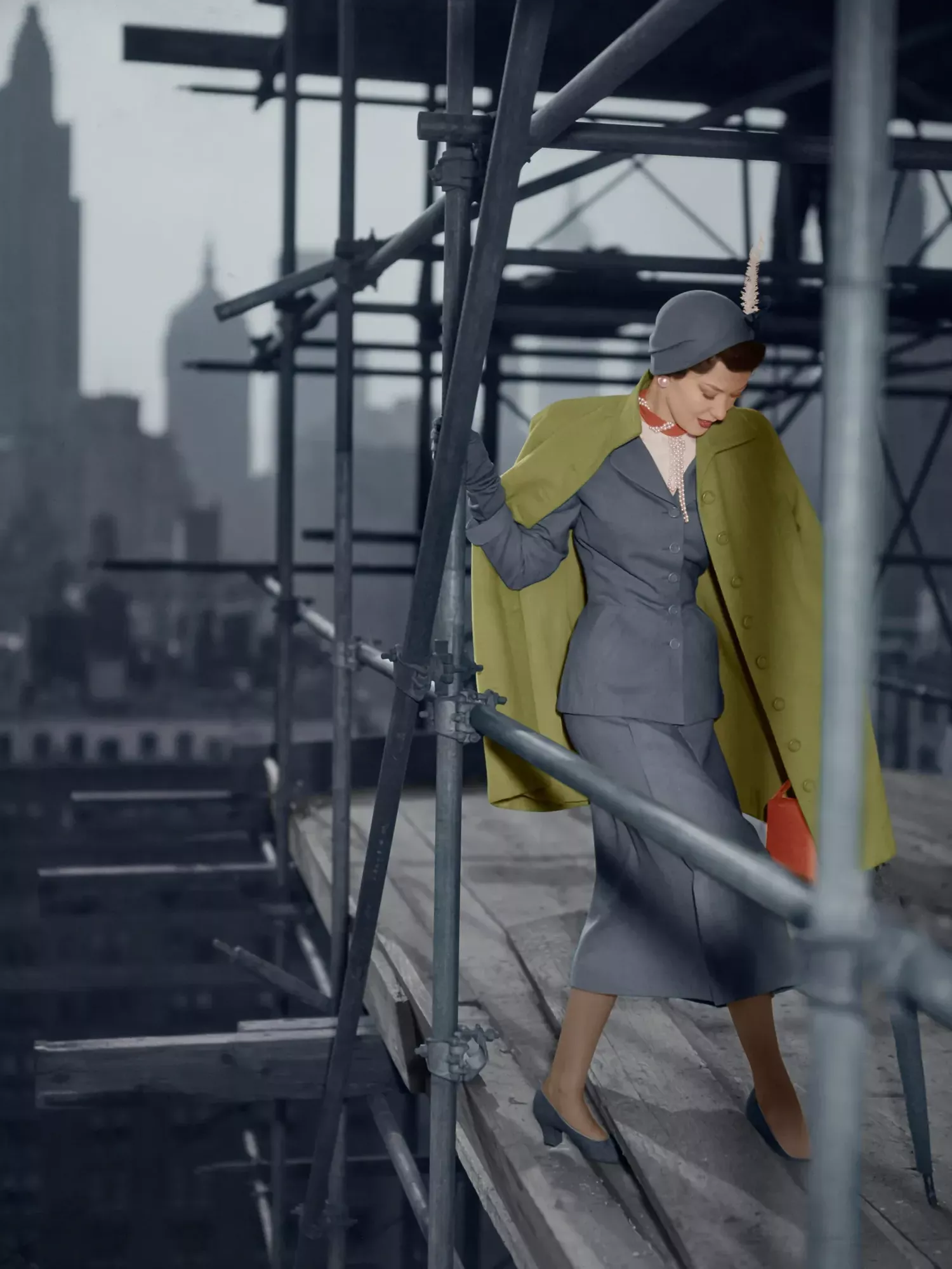
Barbra Mullen in a Vincent Coppola suit. Photo: Erwin Blumenfeld
Barbara Mullen, a four-time Vogue cover girl, was counted among the top 10 American models working in the 1950s, alongside beauties like Jean Patchett and Dovima. Born in New York, she was raised by a single mother. While she was working in a beauty salon after finishing high school, a stranger suggested she try modeling; Mullen quickly found a spot showing clothes in the custom salon at Bergdorf Goodman. When Vogue wanted to shoot one of the gowns presented there, like Cinderella, Mullen was the only one who fit it and so she landed her first credit in the magazine in 1947, and became a paradigm of “a new kind of beauty.”
“It starts with bearing, and an assured grace,” the magazine noted. “It is, of course, a whole new attitude. The ideal walk is now from a flexible waist, with shoulders small, the neck held straight and high. Since the little waistline is the common denominator of all the new clothes, the new carriage is easier….” Mullen at 5’ 9”, with a 20-inch waist, was in high demand. She was a favourite model of Lillian Bassman and Willian Klein who once described her as a “tough Irish American.” Moving to Paris in the mid-1950s Mullen continued to work, retiring prior to the Youthquake. She took up residence in Switzerland where she ran a fashion shop, Barbara’s Bazar and contributed to Annabelle magazine. In 2019 she left Zurich for New Mexico, where she lived out her final days.
Marc Bohan, Designer Who Spent 30 Years at Christian Dior, 97
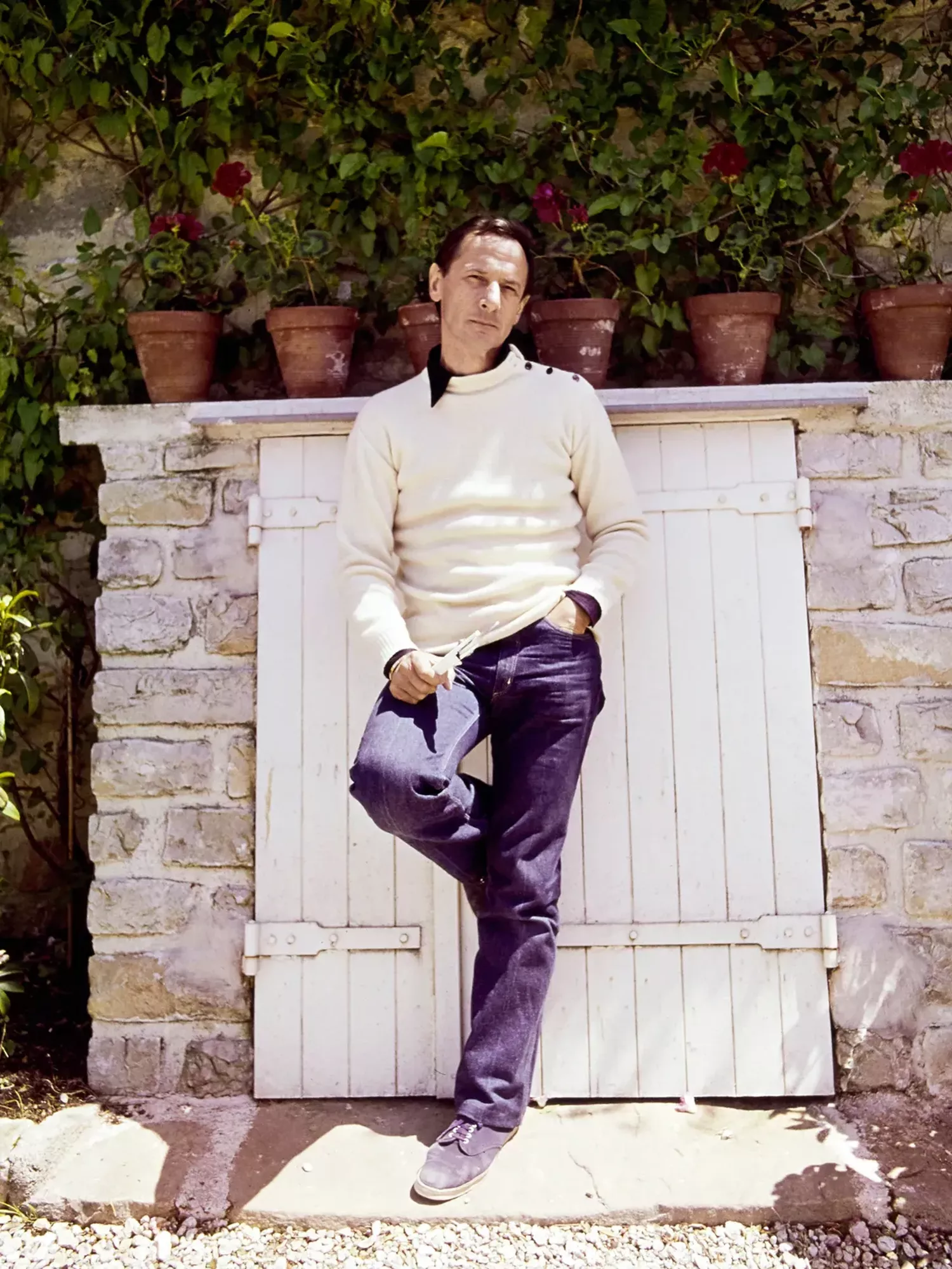
Marc Bohan at home at Le Closeau in Fontainebleu, France. Photo: David Massey
15 years into his 30 year tenure at Christian Dior, Vogue described Marc Bohan as “a man of warm temperament and precise tempo.” The article was about the designer’s country home and the author noted that “Chez Bohan, nothing is haphazard, nothing left to chance.” All of the qualities are apparent in this Frenchman’s work for Christian Dior. There, he kept pace with the times without ever forsaking the values of the maison. He was forever finding a balance between continuity and change.
Born in Paris, he studied in Sceaux before becoming an assistant to Robert Piguet (1945-49), Edward Molyneux (1949-51), and a designer at Madeleine de Rauch, all houses that flowered in the interwar period. After showing one collection under his own name, Bohan joined Patou couture as the lead in 1954 only to leave four years later to begin his tenure at Christian Dior. Hired to design the Dior London line, he succeeded the wunderkind Yves Saint Laurent as head designer and art director in 1960. Vogue raved about Bohan’s debut collection. “After the first 10 minutes of the showing, the scent of triumph was in the air. What went into Bohan’s design triumph was a certain amount of originality; the fillip of change without the fear of ‘looking strange’; an enormous helping of impeccable Dior making; a great deal of consideration for the wearers; a large measure of the most beautiful materials the world has to offer; a certain unexplainable but surely recognizable come-hither. What will remain with those who saw the whole collection and, we think, with those who wear the clothes this spring, is an impression of lavishness, beauty, and a kind of tender, delicious becomingness.”
There was a surprising freshness to Bohan’s work that owed something to his attachment to a streamlined Deco vibe, which had a second fame in the 1970s. Yet his ideal was not a fresh faced flapper but a sophisticate. “The Dior woman is a woman—not a girl—and a pretty woman. She understands luxury, demands luxury—in understandable clothes. Marc Bohan has given her the moon,” noted Vogue in 1971.
Looking back at the New Look in 1987, Bohan said this of Monsieur Dior: “What he did was more.” Bohan, on the other hand, did more with less. As he told Hamish Bowles in 1997: “I tried to make things that suited and pleased the customer, not to make some striking change, some fun thing every season. I thought that was over. I kept the clientele. That was the main idea, not to make headlines.” The discreet charm of the bourgeoisie….
Bohan left Dior in 1989 and worked for Hartnell in London from 1990 to 1992. He was named a Chevalier de la Legion d'Honneur, 1979; and belonged to the Ordre de Saint Charles, Monaco.
George Kolasa, Fashion Marketing Executive, 57
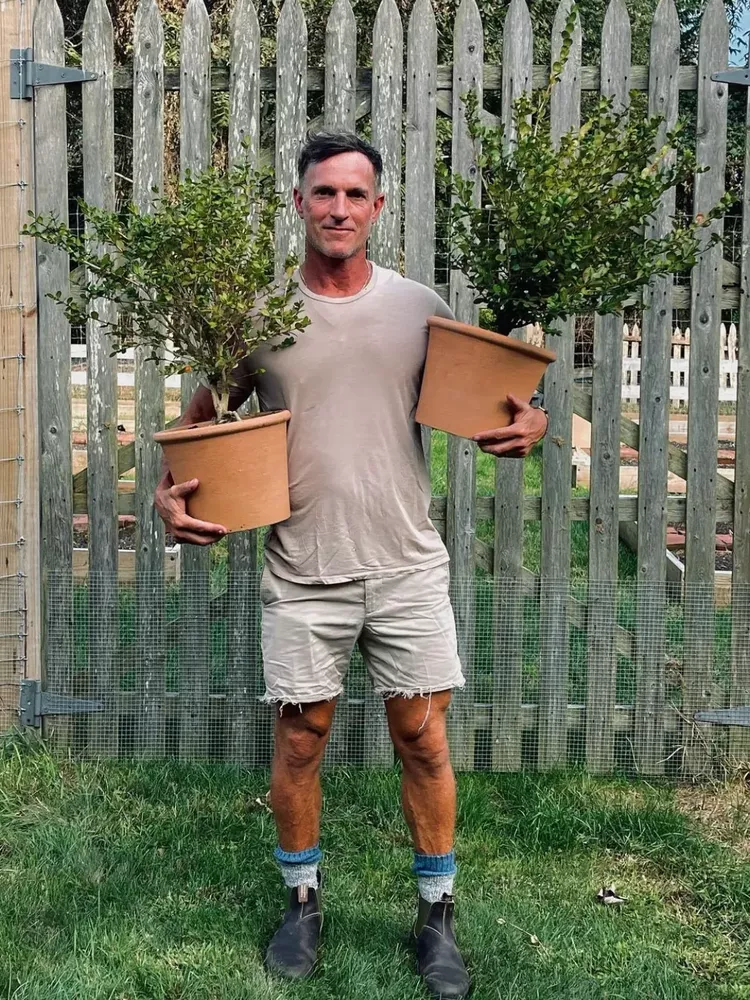
Photo: Lincoln Pilcher
“I never put myself out there publicly in my career. My job was to communicate on behalf of a brand or designer. That was my main purpose, I kind of was old-school in that way,” George Kolasa was a fashion marketing executive with 30 years of experience in the industry. In 2022, the beloved insider was diagnosed with brain cancer and documented his experience on Instagram, working his connections to raise over $500,000 for a cure.
Born in Queens and raised on Long Island and Arizona, he studied marketing and segued into modeling. Relocating to Los Angeles, he worked for a talent agency, who sent him to New York. Having lost his mailroom job he found another, in Mademoiselle’s fashion closet through a friend. Returning samples, he was noticed by Ralph Lauren and brought on board. Kolasa went on to work with Tommy Hilfiger, Karl Lagerfeld’s namesake brand, and Giorgio Armani, and finally, Burberry.
John Barrett, Celebrity Hair Stylist, 66

John Barrett (in blue shirt) at work in his Bergdorf Goodman salon. Photo: Arthur Elgort
John Barrett, the Irishman who worked for years 13 years from a penthouse suite above one of the toniest shops in New York, and whose salon provided inspiration for Plum Sykes’s book Bergdorf Blondes, was surprisingly down to earth. No matter that he worked with Princess Diana, Martha Stewart, and the female leads of Friends, his motto, noted Vogue, was “Service without snottiness.”
Born in Limerick, Ireland, one of 10 children of a laborer and homemaker, Barrett left home, aged 13 and scraped together a living on the streets of London, sometimes not knowing where he’d sleep. “I left home early, so it was a question of finding something I could do, rather than having a calling. I was trying to find a job I wouldn’t get fired from,” Barrett once said. He applied for a three-year hairdressing apprenticeship and finished it in 12 months. He found work in the city, and when he was employed at Michaeljohn, a miscommunication turned into a boon, when he did Liz Taylor’s hair. Having won a green card lottery, Barrett moved to Los Angeles in the ’80s. Sober by the end of the decade he returned to London. In 1995 he moved back to New York and was employed with Frédéric Fekkai, then working out of Bergdorf Goodman. By chance he did store president Dawn Mello’s hair and when Fekkai moved out she invited Barrett to move into the founding family’s former home in the clouds, high above Fifth Avenue. Part of the allure of his salon was that it was full-service, offering hair and beauty. In 2019 left his castle in the sky to open on his own place.
Jane Birkin, Actor, Musician, Style Icon, 76
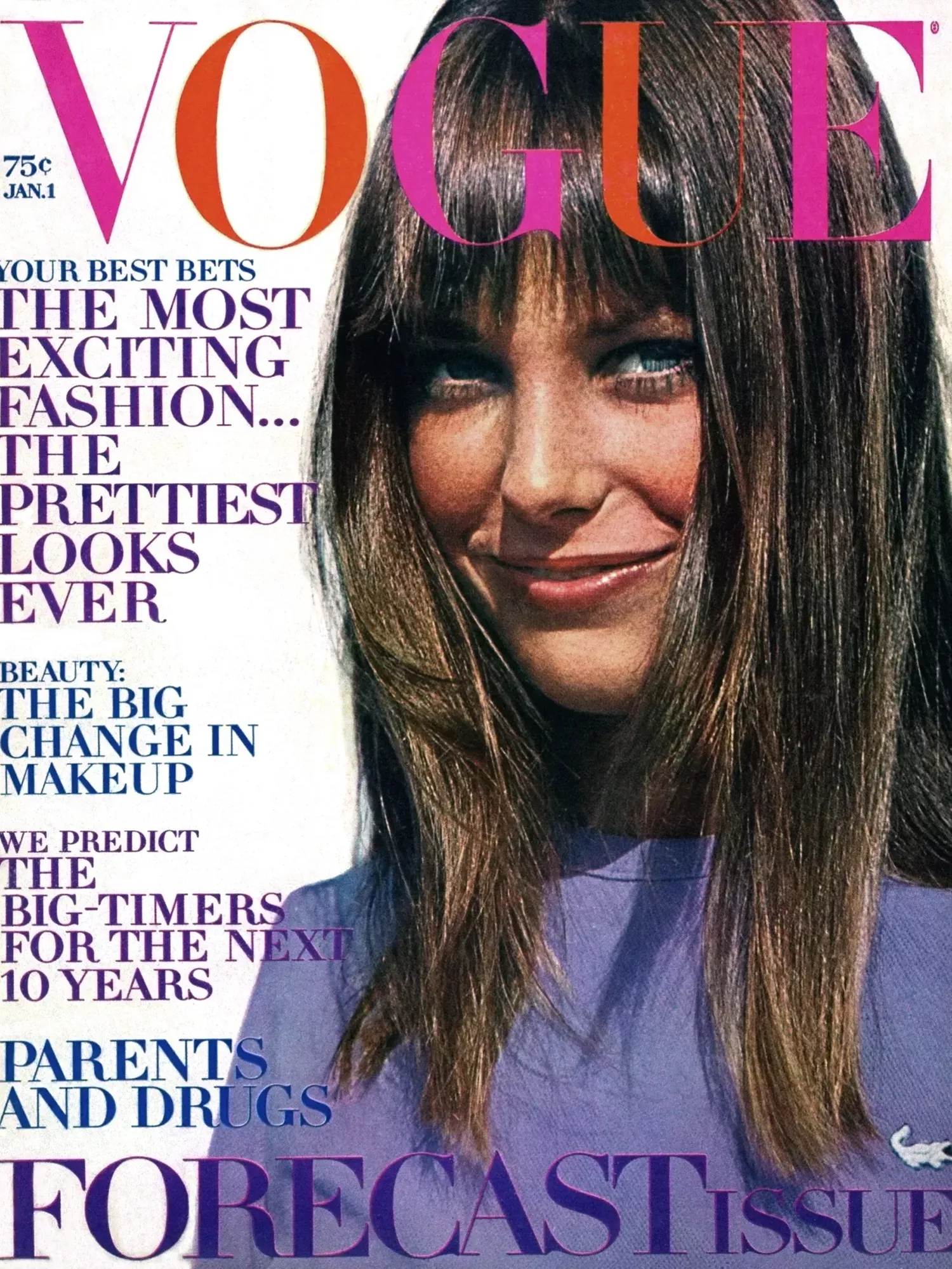
1970 Vogue. . Photo: John Cowan
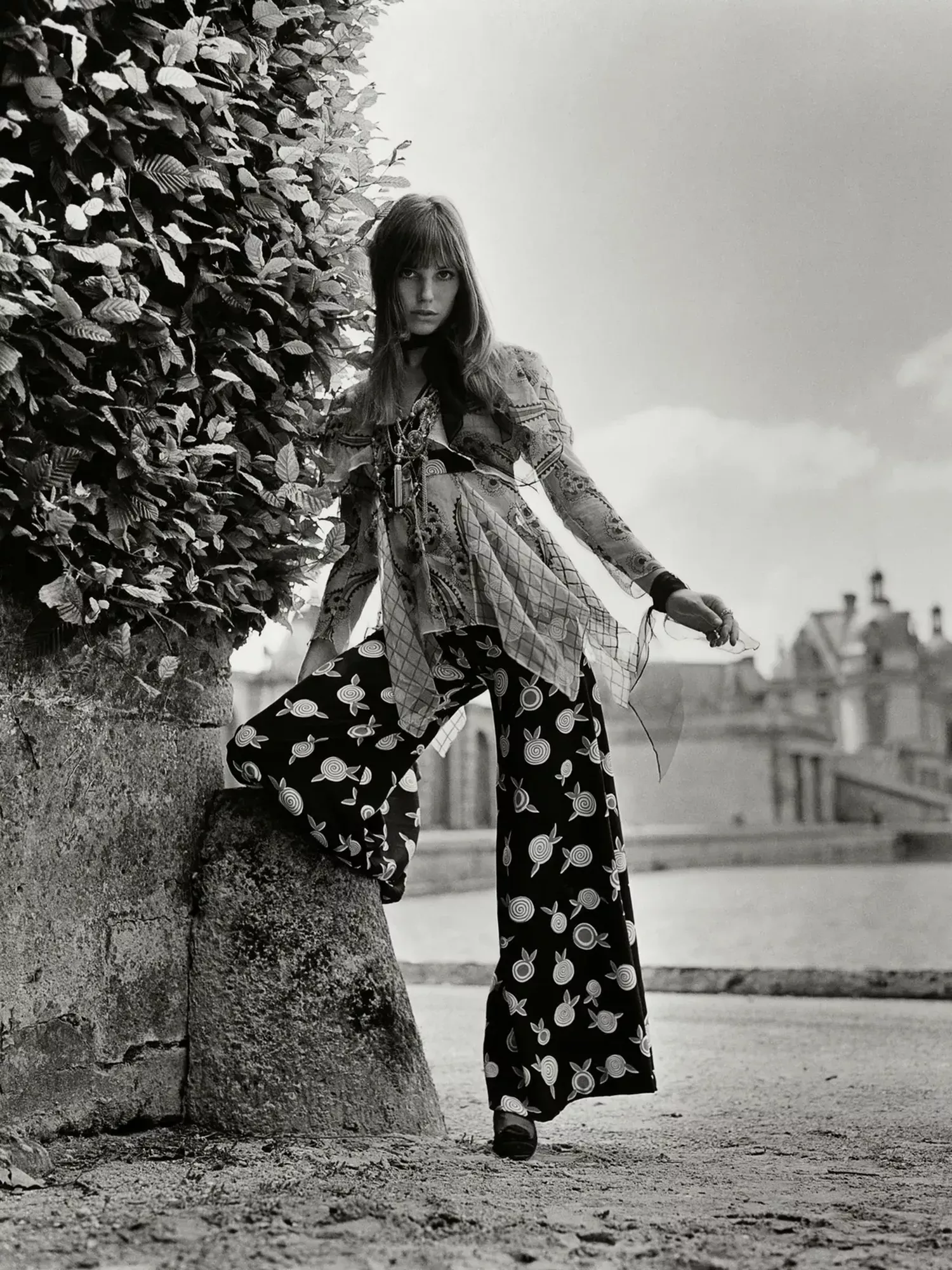
Jane Birkin in Ossie Clark. Photo: Patrick Lichfield
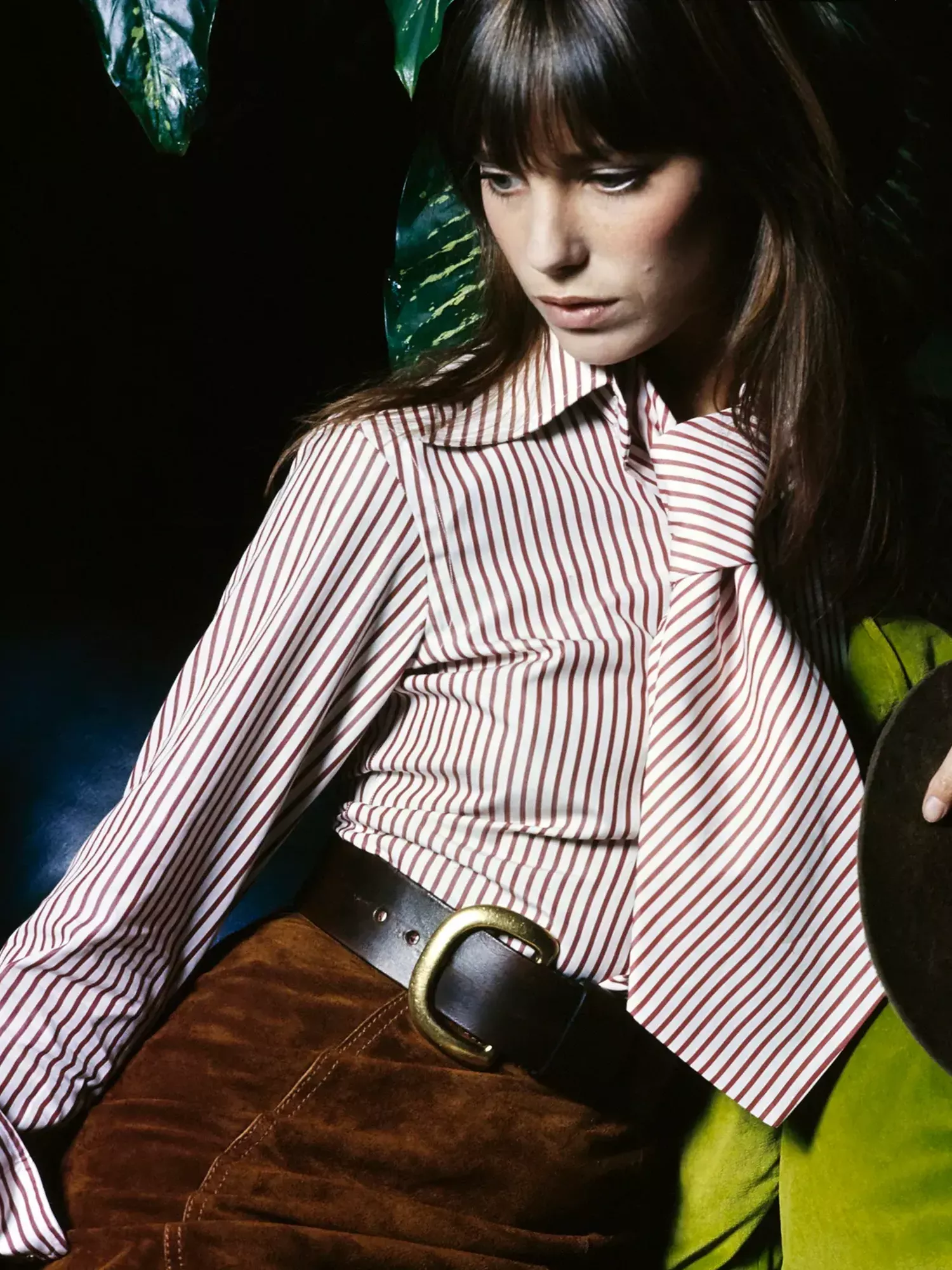
Jane Birkin in a shirt and matching tie by Custom Shop. Photo: Patrick Lichfield
Jane Birkin, the queen of effortless cool, was born in London and took first to the stage, and then to film: The actor appeared in the buff in Michelangelo Antonioni’s fashionable 1966 film, Blow-Up. A year earlier she had married John Barry, the James Bond composer, with whom she had a daughter, Kate. After their divorce in 1968, she went to France to film the movie Slogan and fell for her co-star Serge Gainsbourg. Within a year she embarked on a music career with him, recording the breathy, sexy, and scandalous “Je t’aime… moi non plus.” Birkin was the recipient of many honors across fields; she was awarded the French Ordre National du Mérite twice, in 2004 and 2015, and was named an OBE in 2001.
Birkin’s easy, sometimes androgynous style, which ranged from wide-leg jeans and a wicker basket to a tee and a Hermès Birkin – the cult bag made and named for her – was ever a subject of fascination. And it seems to have been passed on to her daughters Charlotte Gainsbourg and Lou Doillon.
Chris “Spanto” Printup, Born x Raised Co-Founder, 42
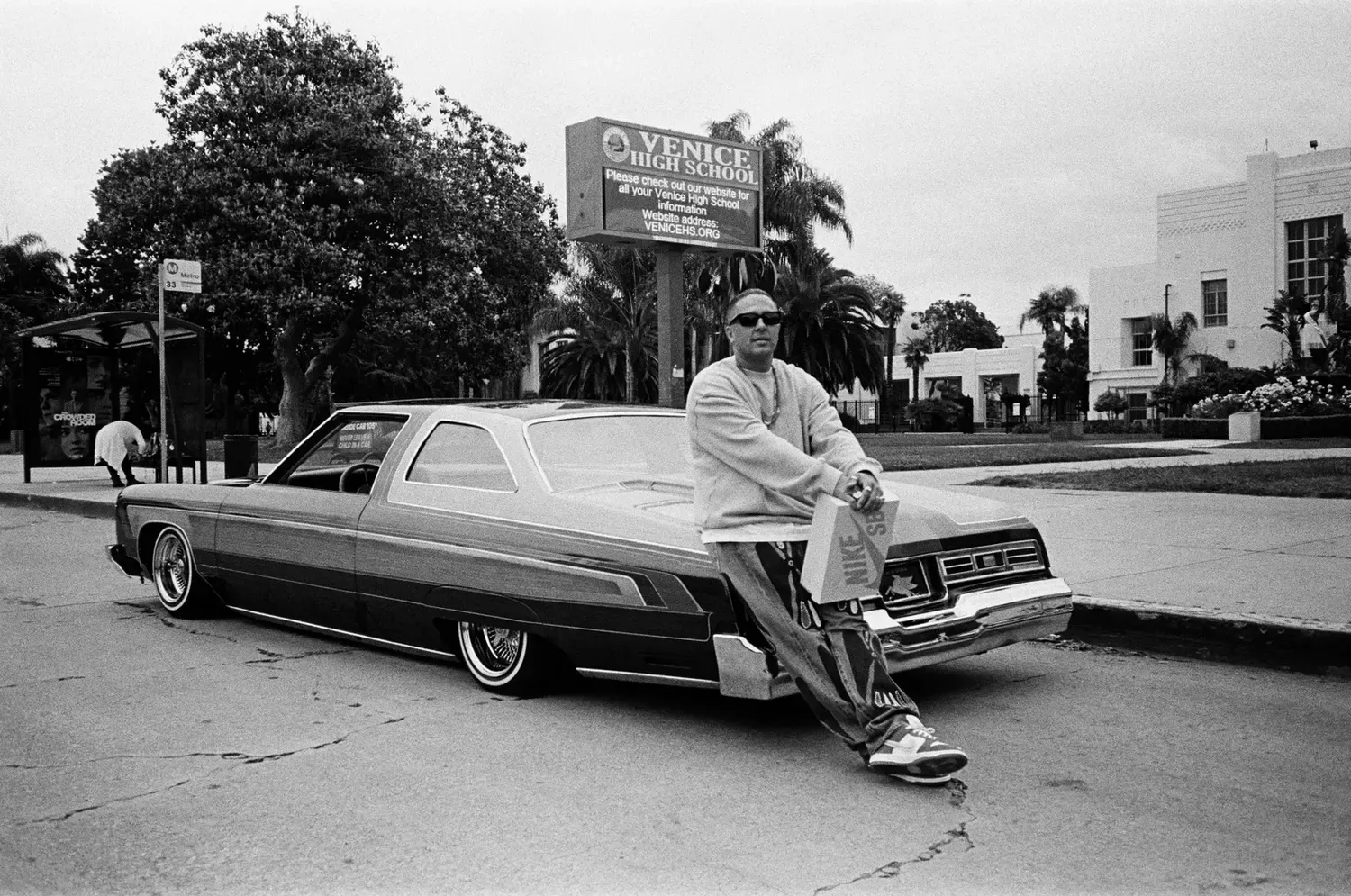
Chris “Spanto” Printup. Photo: Estevan Oriol
Born in Venice, California, to Indigenous parents, Chris “Spanto” Printup experienced hardships, including beating two bouts of cancer, but was always able to find the bright side of things and lift people, and communities, up. He had, said actor Travis Bennet, “a fucking heart of gold.” Printup conceived of Born x Raised, the streetwear brand he founded with Alex Erdmann/2Tone while incarcerated, according to The New York Times. For this self-taught designer, Born x Raised was both a “love letter” to L.A. from a native who knew it inside and out, and a way to elevate Indigenous culture. Earlier this year the brand collaborated with Levi’s on a collection honoring Printup’s Seneca father Butch.
Valentin Yudashkin, Russian Designer, 59
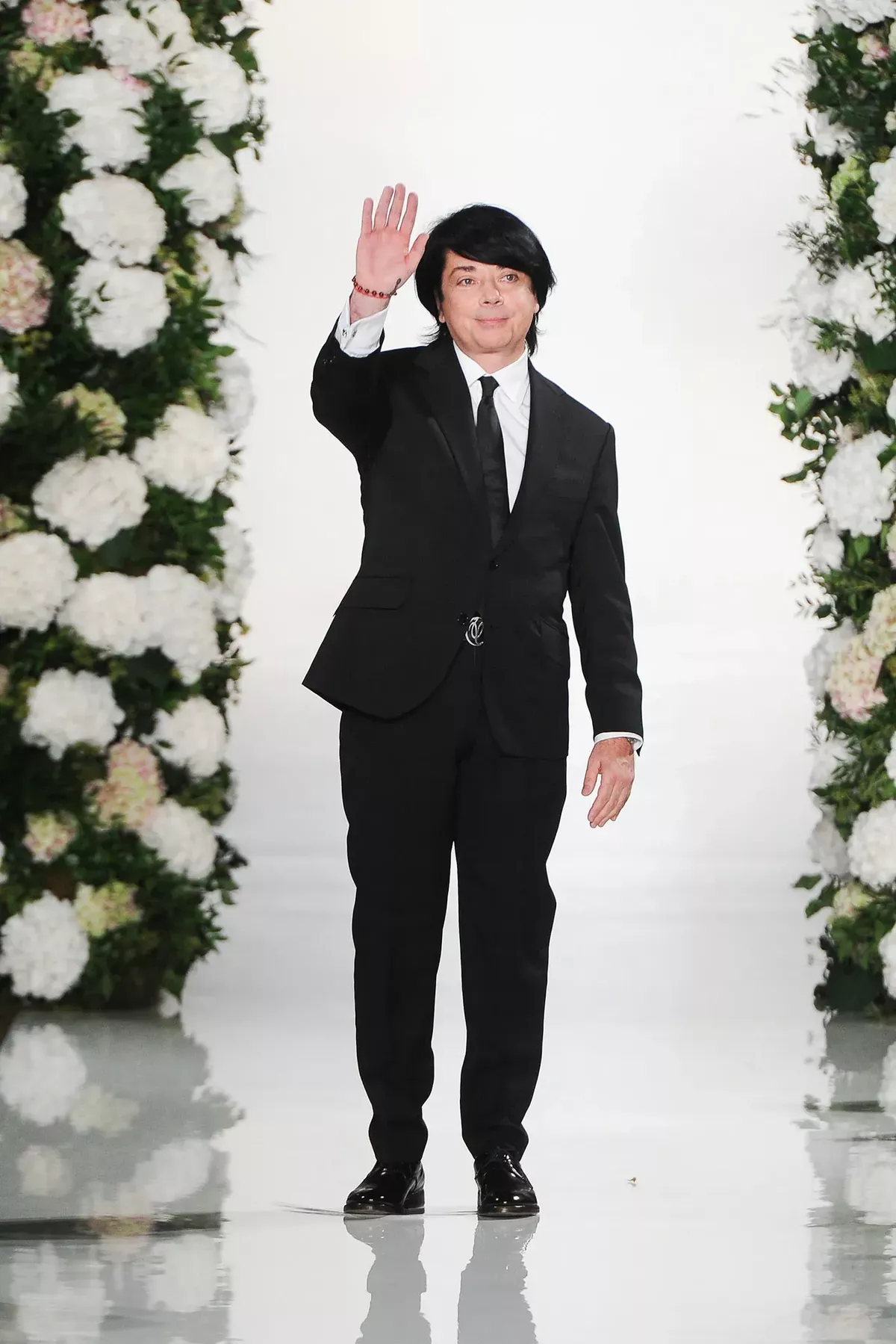
Photo: Kim Weston Arnold / Indigitalimages.com
In 1996 Valentin Yudashkin became the first Russian designer invited to be a member of the French Federation of Haute Couture and Ready-to-Wear. That same organization banned a digital showing of his collection in 2022 allegedly because of his silence on Ukraine. Born in Moscow Oblast, Yudashkin studied the history of traditional costumes and decorative cosmetics and in the late ’80s, reported Russia. Beyond, in the designer-created his own Vali-Moda Fashion Theatre. He also dressed the former First Lady Raisa Gorbachev and became, wrote Luke Leitch, “Russia’s first post-perestroika fashion designer to earn great domestic fame.” Yudashkin broke through to the west with his Faberge collection of 1991, which was as sparkling as it was unwearable. Twenty-three years later Vogue Runway’s Nicole Phelps would declare the designer “an outlier” whose “niche is super flashy evening gowns.” From couture, the designer moved into ready-to-wear, and was involved with the establishment of Moscow Fashion Week. The designer received many awards and accolades, including the French Legion of Honour in 2013. He is succeeded by his daughter Gala Yudashkina.
Mary Quant, Youthquake Designer, 93
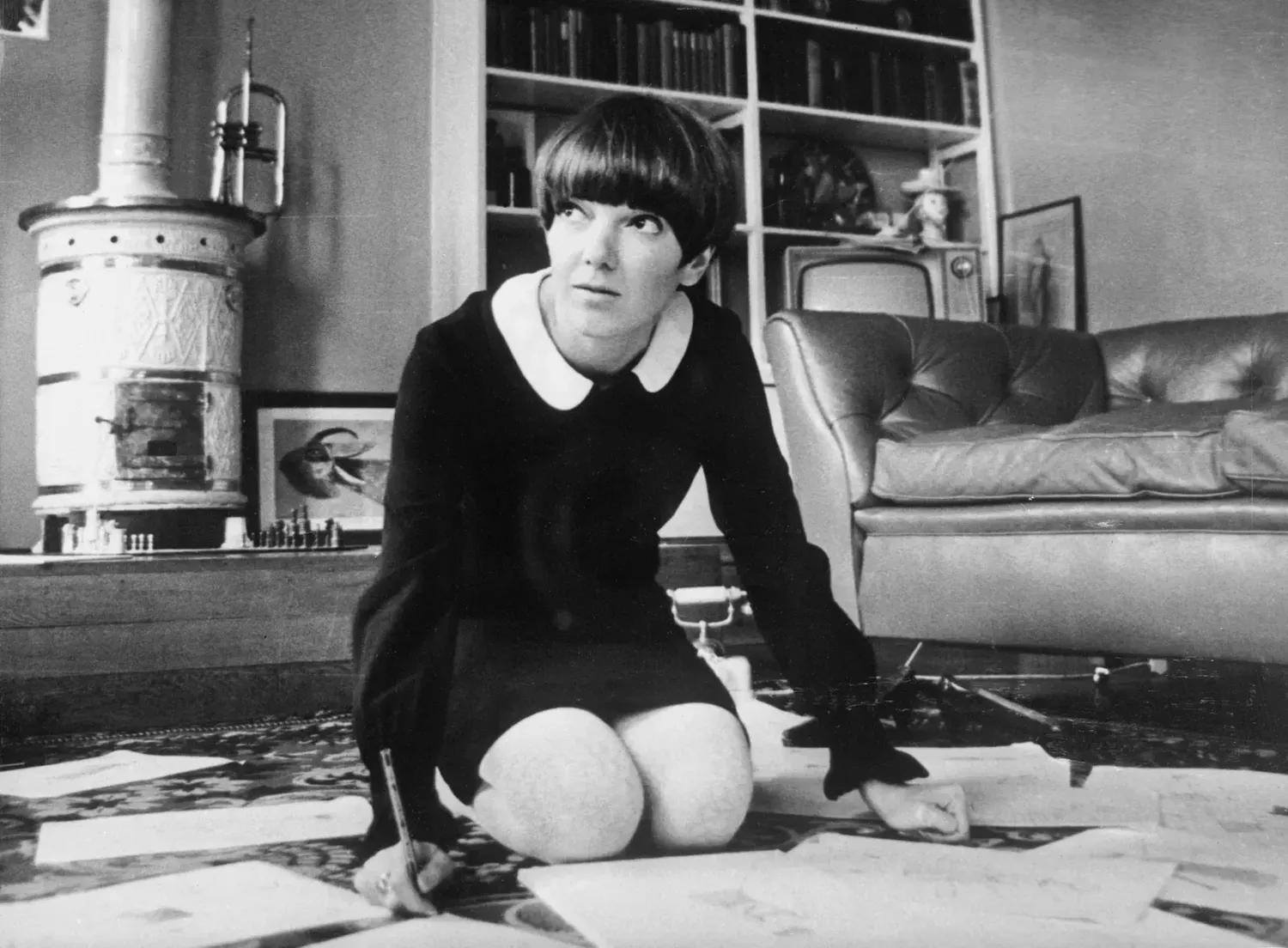
Mary Quant in 1965. Photo: Arthur Steel
Since 1966 Mary Quant’s name has been synonymous with the mini-skirt. Speaking more broadly, the designer was at the center of what Vogue called the Youthquake. In the 1960s, teens were not content to dress like their parents or follow their career paths. Quant was designing for like minded women of her generation. In 1955 this London-born, Goldsmiths college-trained designer set up Bazaar, with Alexander Plunkett-Greene, her partner in life and work, and their friend entrepreneur Archie McNair, on the King’s Road, the main shopping artery of Swinging London. They didn’t stop at minis; the tights you wore with them followed, as did makeup – a world of Mary Quant. Petite and bright-eyed with her sharp Sassoon cut, the designer was the ultimate embodiment of the brand. She stepped away from the business in 2000 having become an OBE in 1966. She was granted a Damehood in 2015.
Michael Roberts, Artist, Fashion Editor, Renaissance Man, 75
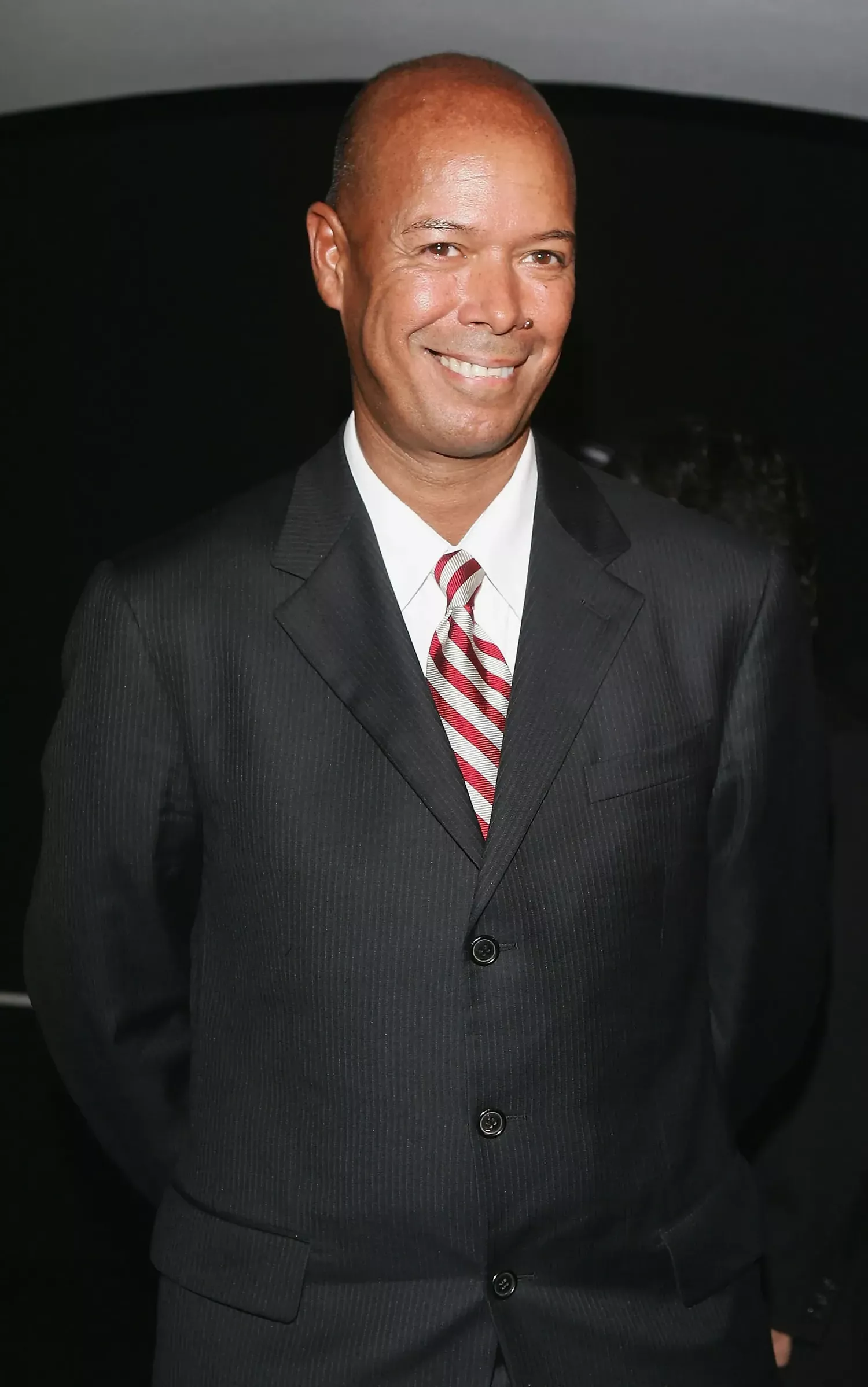
Michael Roberts in 2005. Photo: Pascal Le Segretain / Getty Images
A man of discerning taste, wit, and many talents, Michael Roberts worked as an illustrator, writer, stylist, photographer, and director throughout his five decades in fashion. Born in Buckinghamshire, he studied drawing and fashion at school, after which he worked with fashion editor Molly Parkin at Nova and at London’s Sunday Times, where he wrote an acerbic fashion column. In 1979 he joined Tina Brown at Tatler as style and art director. It was during his tenure that Vivienne Westwood was unforgettably photographed as Margaret Thatcher for its cover. Following Brown to Vanity Fair in New York, Roberts began to further explore photography and filmmaking. He won an MTV Award for a Bryan Ferry music video, and more recently directed a biopic on Manolo Blahnik. Having never lost his passion for illustration, Roberts published The Jungle ABC, in 1998. Other books followed—as did acclaim. In 2022, Roberts was appointed Commander of the Order of the British Empire (CBE).
Paco Rabanne, Space Age Designer and Numerologist, 88
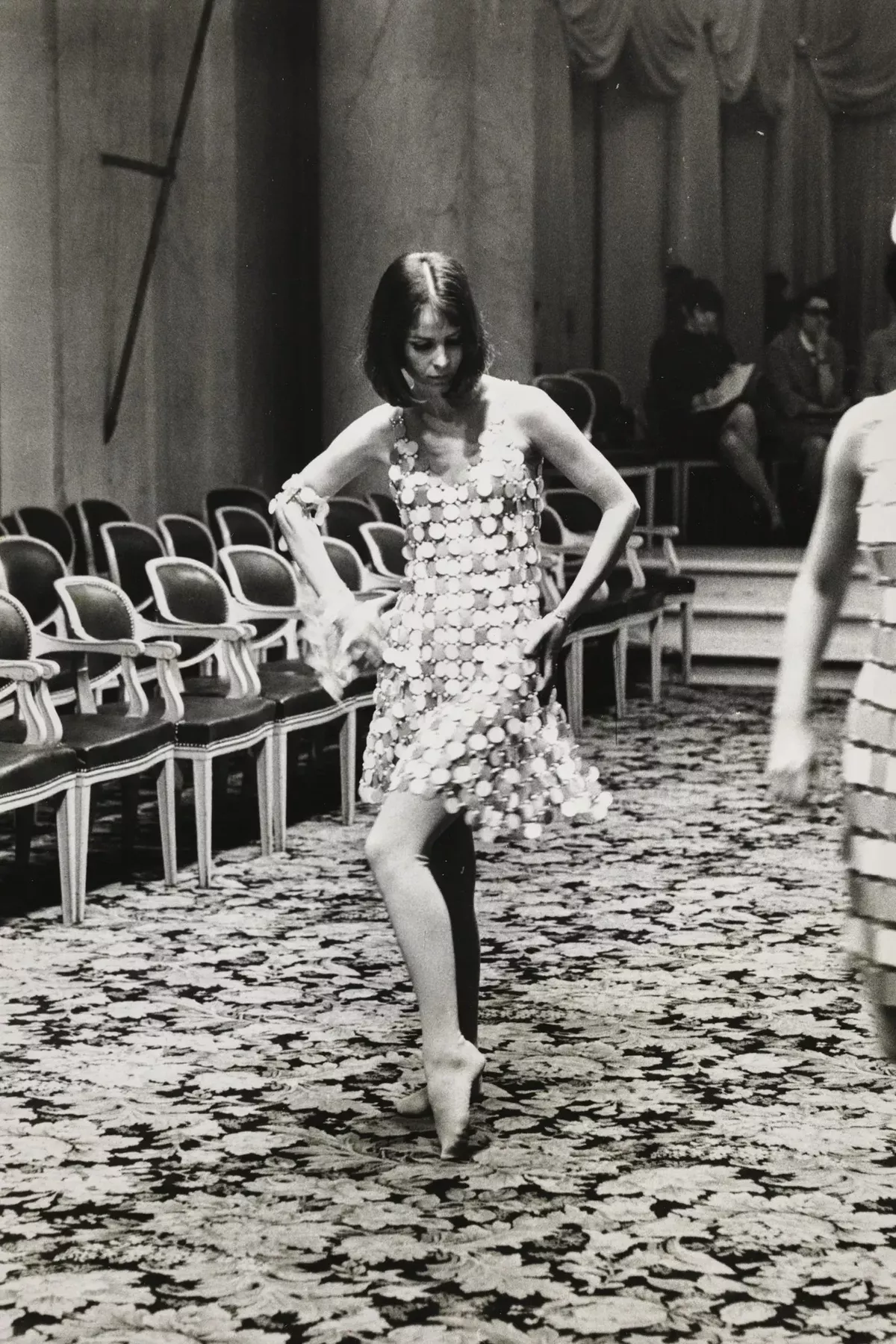
A Paco Rabbane dress. Photo: Jack Robinson
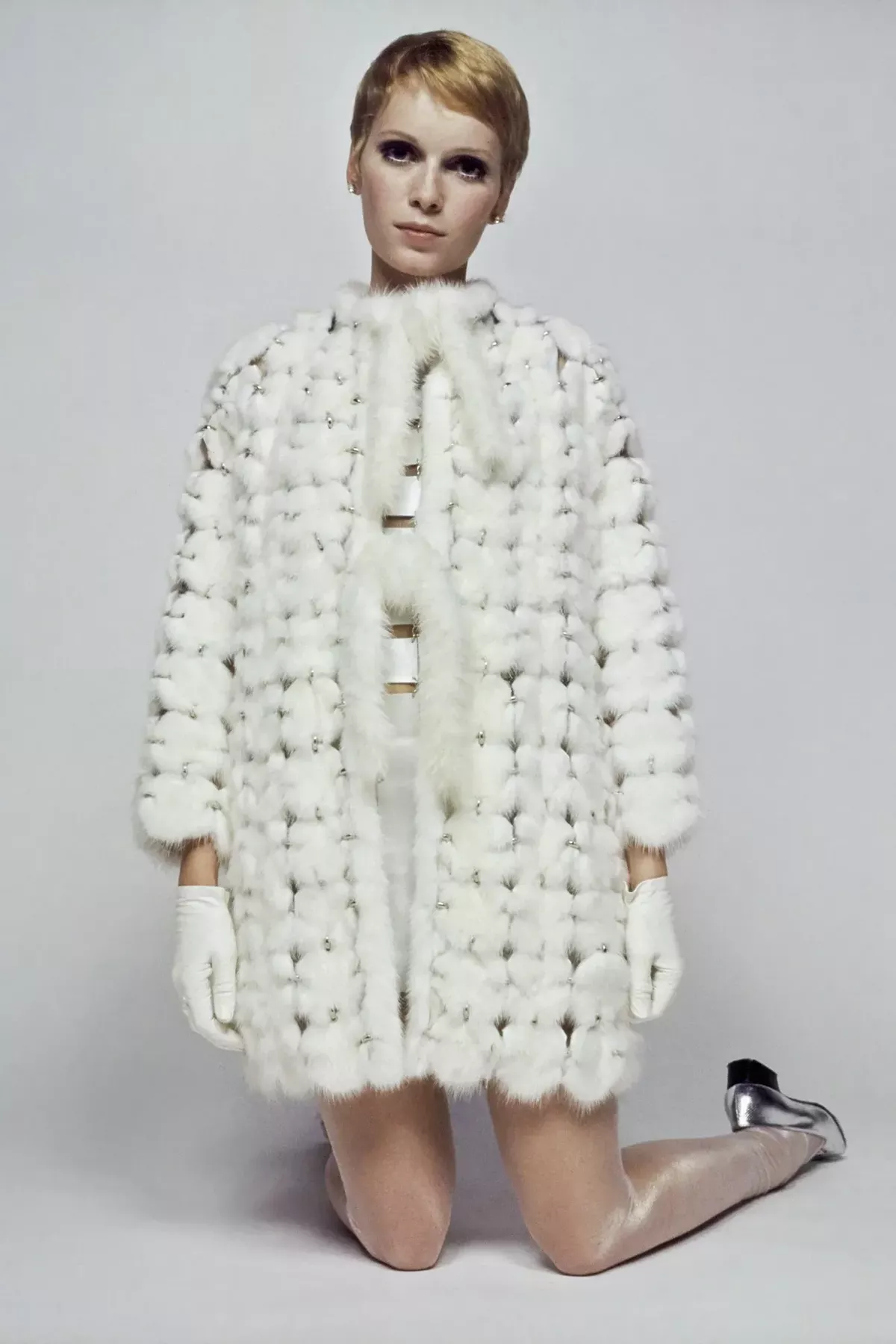
Mia Farrow in Paco Rabbane. Photo: David Bailey
“There are only two geniuses in Spain,” declared the confident Surrealist Salvador Dalí, “me and Paco Rabanne.” The designer did, in fact, leave behind a shining legacy; one that grows in relevance as designers start piecing together upcycled and unusual materials in an effort to combat climate change. Some of Rabanne’s early dresses made use of leftover leather; although in 1968 for chanteuse Francoise Hardy he created a dress of gold and diamonds thought to be the most expensive made at that time.
Rabanne’s use of plastics and his costumes for Jane Fonda in Barbarella cemented the Spaniard’s reputation as a Space Age designer, alongside André Courrèges and Pierre Cardin. Rabanne also believed he had past lives, and had once lived on a planet in the cosmos. His earthly existence began in the Basque town of Pasajes, with tragedy; his father was executed by Franco’s fascist regime. At age three, his mother, who worked for Cristóbal Balenciaga at his Eisa atelier in Spain, relocated her family to Paris, where Rabanne became a student of architecture at the École des Beaux Arts.# His first involvement with fashion was as a jeweler. In 1966 he made his debut with a collection called “Manifesto: 12 Unwearable Dresses in Contemporary Materials” and is likely the subject of William Klein’s satire in Qui êtes-vous, Polly Maggoo? It was a shockingly unconventional and forward looking approach to design, peek-a-boo armor for the modern woman.
Tatjana Patitz, Supermodel, 56
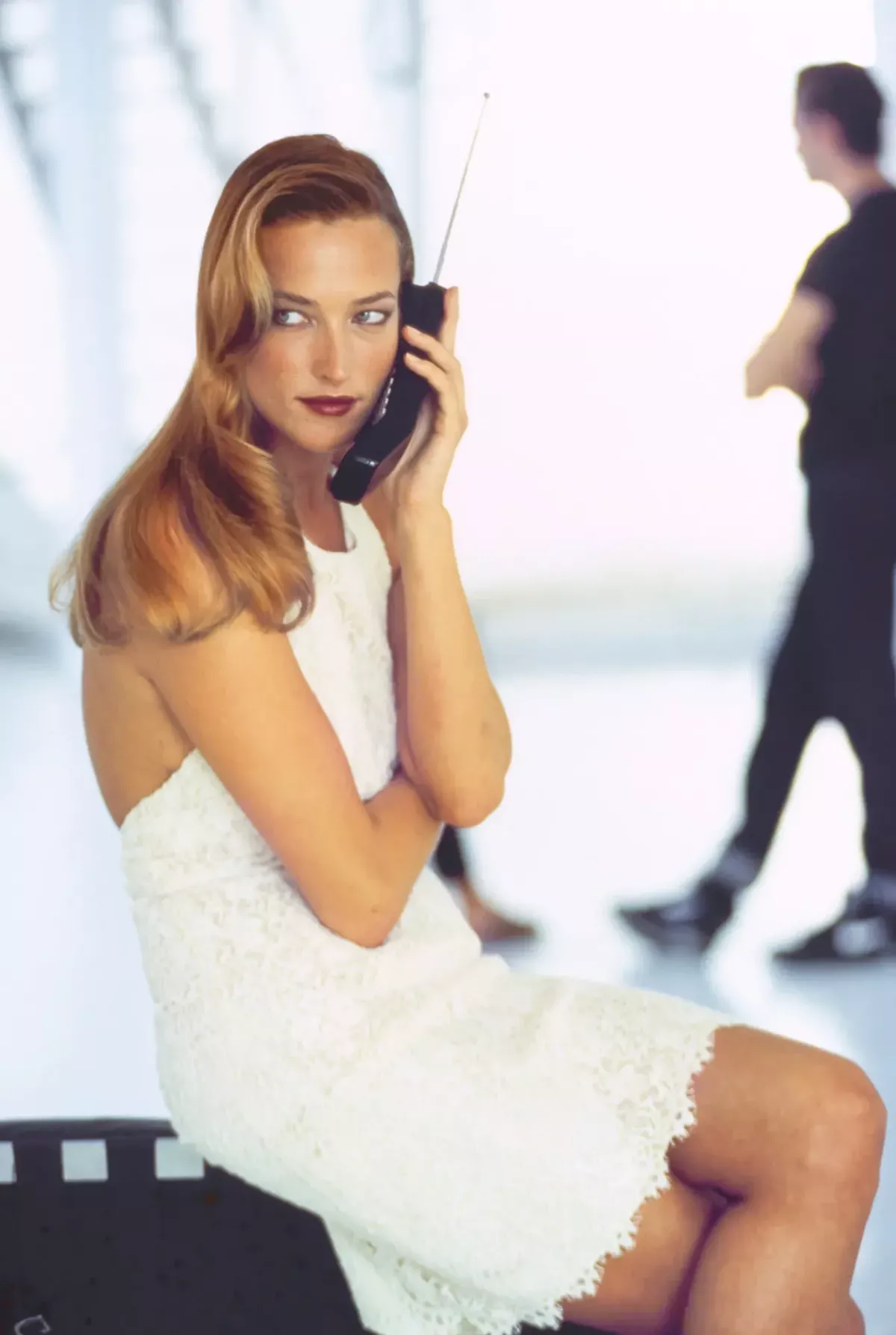
Tatjana Patitz in Victor Alfaro. Photo: Arthur Elgort
An oval-faced German beauty with a gentle air and a warm heat, Tatjana Patitz got her first taste of supermodeldom in 1988 via photographer Peter Lindbergh, who shot her for “White Shirts: Six Supermodels, Malibu.” Two years later she was again in front of his lens with four other one-named wonders, memorialised on the January 1990 cover of British Vogue, the very one that inspired George Michael to ask the quintet to lip sync through his “Freedom ’90” video. She retreated from fashion, settling in California to raise her son Jonah and tend to her ranch and animals. “Tatjana was always the European symbol of chic, like Romy Schneider-meets-Monica Vitti,” remembered Anna Wintour, chief content officer of Condé Nast and global editorial director of Vogue. “She was far less visible than her peers – more mysterious, more grown-up, more unattainable – and that had its own appeal.”
